Is It True In The Us That The Amount Of Children Raised By Their Grandparents Has Increased?
In 2022, seven.7 meg children were living in the same household as at least one of their grandparents.4 This translates into 10% of all children under the age of xviii in the U.South. A sizable minority of these children are not only living with their grandparent, only are being cared for by their grandparent as well. All told, four% of minors—more than 3 one thousand thousand children—autumn into this category.
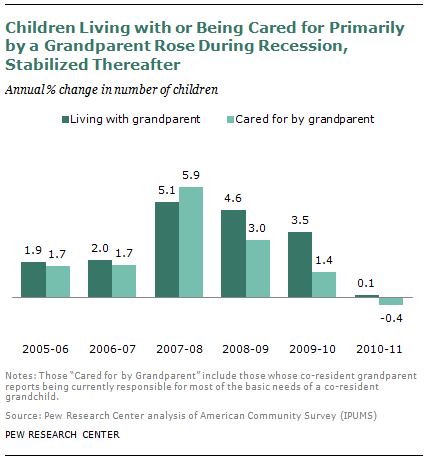 The number of children living with or existence cared for primarily past grandparents rose gradually from 2000, when data were first nerveless, and then began a more precipitous rising after the onset of the recession in 2007. The number of children with co-resident grandparents rose past 5 percentage from 2007 to 2008, and the number of children beingness cared for primarily past a grandparent rose by almost 6 percent during that same period.
The number of children living with or existence cared for primarily past grandparents rose gradually from 2000, when data were first nerveless, and then began a more precipitous rising after the onset of the recession in 2007. The number of children with co-resident grandparents rose past 5 percentage from 2007 to 2008, and the number of children beingness cared for primarily past a grandparent rose by almost 6 percent during that same period.
The increases have been more modest since 2008, even so, and from 2010 to 2022 both the number of children living with a grandparent and the number being cared for by a grandparent remained almost unchanged.v
The Likelihood of Living with or Being Cared for by a Grandparent
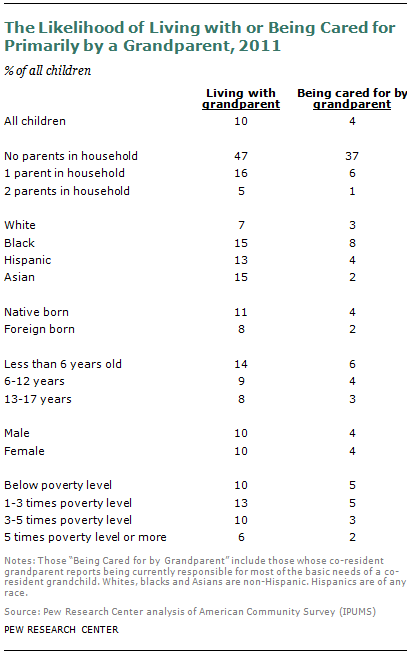 Children who are living autonomously from their parents are among the most likely to be living with a grandparent; fully 47% do. In contrast, children living with one or both parents are much less probable to be living with a grandparent. Some sixteen% of children living with i parent are also living with a grandparent, and 5% of children who live with both parents live with a grandparent.
Children who are living autonomously from their parents are among the most likely to be living with a grandparent; fully 47% do. In contrast, children living with one or both parents are much less probable to be living with a grandparent. Some sixteen% of children living with i parent are also living with a grandparent, and 5% of children who live with both parents live with a grandparent.
Similarly, children who are living apart from their parents are also most likely to have a grandparent caregiver; more than one-third (37%) do. Among children living with one parent, six% have a grandparent caregiver. Merely 1% of children living with two parents have a grandparent caregiver.
Black and Asian children are more likely than Hispanic or white children to be living with a grandparent. Some 15% of both blacks and Asians are doing so. For Latinos, the share is 13%, and just vii% of white children are living with a grandparent.
Blackness children are at least twice equally likely as children of other racial and ethnic groups to be under the care of a grandparent. Some eight% of blackness children autumn into this category. Amongst Latino children, the share is 4%. Some 3% of white children are cared for primarily past a grandparent. While a relatively large share of Asian children alive with their grandparents, simply 2% are being cared for primarily by those grandparents.
Native-built-in children are more than probable to be living with a grandparent than are foreign-born children, and are more likely to be cared for primarily by a grandparent, equally well. Some 11% of native-born children, compared with viii% of those who are foreign-born, are living with a grandparent. And 4% of native-born children are cared for primarily by a grandparent, compared with two% of strange-born children.6
This may seem counterintuitive, given that immigrant families are more apt to live in multigenerational households. However, information technology is likely that if a kid was born outside of the U.S., the grandparent may still be residing outside of the U.S. and thus exist unavailable for co-residence or caregiving.
Younger children are particularly likely to be living with a grandparent—fully 14% of those under the age of half dozen are. In comparing, 9% of children ages 6 to 12 and 8% of those ages 13 to 17 live with a grandparent. A similar design emerges in terms of receiving intendance from a grandparent. A grandparent is the main caregiver for half-dozen% of those nether age 6. In comparison, four% of children ages 6 to 12 are cared for primarily by a grandparent, as are iii% of those ages xiii to 17.
Children living in or well-nigh poverty are more likely to exist living with a grandparent, or cared for primarily by a grandparent, than are children who are more economically advantaged. Some 10% of children living beneath the poverty line are living with a grandparent, while just vi% of those in households with incomes at least five times above the poverty line are. And while 5% of those whose household incomes are three times the poverty level or less are being cared for by a grandparent, the number drops to 2% for those living in households with incomes at to the lowest degree v times higher up the poverty line.7
The Likelihood of Living with, or Being Cared for by, a Grandparent, by Race and Ethnicity
While the likelihood that a child volition either alive with a grandparent or be cared for primarily past a grandparent varies considerably by race and ethnicity, the demographic patterns relating to grandchild co-residence and care are adequately consistent across racial and indigenous groups. For instance, among blacks, whites, Hispanics and Asians, younger children are more than likely than older children to exist either living with, cared for primarily by, a grandparent. And for all groups, the native born are markedly more than likely than the foreign born to live with a grandparent, or be cared for primarily by a grandparent.
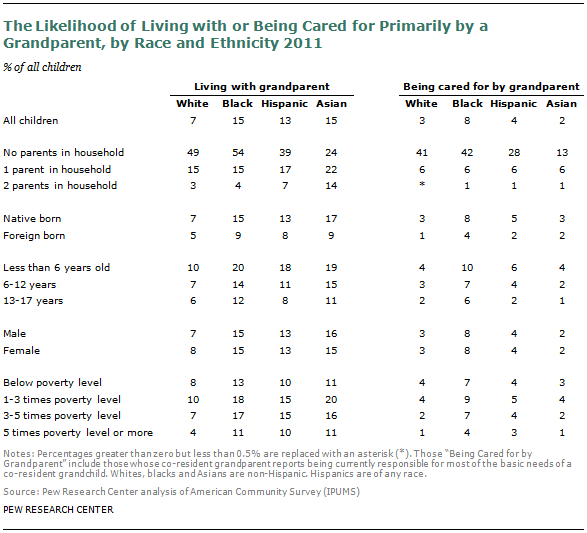
The one characteristic where notable racial and ethnic differences emerge is household construction. White and black children look fairly similar—about half of those who have no parent in the household are living with a grandparent, as are roughly 15% of those who also have one parent in the household and three% of those with two parents nowadays. Amid Hispanic children living apart from their parents, simply 39% are living with a grandparent. Some 17% of those living with one parent live with a grandparent, and 7% of those who have two parents in the household likewise live with a grandparent.
While in most cases the likelihood of living with a grandparent declines precipitously with the presence of one or two parents in the household, amongst Asian children this design is less salient. Just 24% of Asian children who live apart from their parents are living with a grandparent. However, compared with the other groups, a larger share—22%—of Asian children who alive with i parent are likewise living with a grandparent, and fully 14% of those living with two parents are living with a grandparent.
For children in all iv racial and ethnic groups, the likelihood of being cared for primarily by a grandparent is like for those living with either ane parent or two parents. About 6% of those with one parent are existence cared for primarily by a grandparent, as are i% of those living with two parents. Differences persist, though, amidst those children living autonomously from their parents. While merely over xl% of white children and black children in this category are existence cared for primarily by their grandparents, this share drops to 28% for Hispanic children and to only 13% for Asian children.
Profiles of Children who Are Living with or Existence Cared for Primarily by Grandparents
Some other way to look at children living with or being cared for primarily past grandparents is to consider the makeup of those who are in these situations. The contour, or composition, of these children is a function of the general makeup of all children in the U.Due south. and the fact that different subgroups are more or less likely to be living with or cared for by a grandparent. For instance, white children are less probable than other groups to be living with a grandparent. Every bit a event, the total composition of white children living with a grandparent is 38%—far lower than their share in the overall population of children (53%).
In 80% of cases where a child is living with a grandparent, there is also at least ane parent living in the household as well. For half (51%) of these children, there is i parent in the household, and for 29%, at that place are two parents in the household, in addition to a grandparent. Ane-fifth of children living with a grandparent are living apart from their parents.
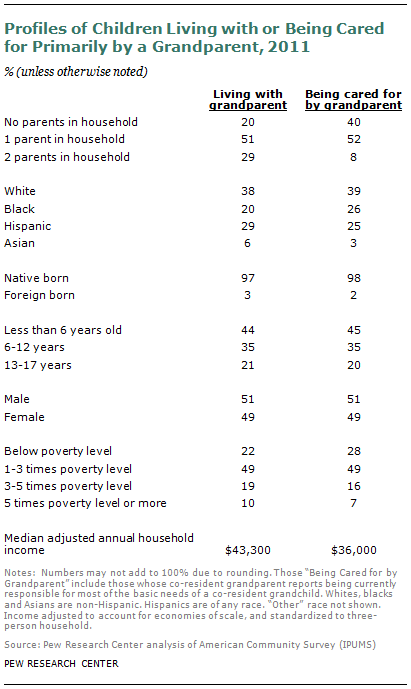 Amongst those children being cared for primarily by a grandparent, 52% are living with ane parent, and 8% are living with both parents. The remaining 40% of children being cared for past a grandparent are living apart from their parents. In comparing, among all children in the U.S., 62% are living with two parents, 34% are living with one parent, and four% are living apart from both parents.
Amongst those children being cared for primarily by a grandparent, 52% are living with ane parent, and 8% are living with both parents. The remaining 40% of children being cared for past a grandparent are living apart from their parents. In comparing, among all children in the U.S., 62% are living with two parents, 34% are living with one parent, and four% are living apart from both parents.
Fully 38% of children living with a grandparent are white, and 29% are Hispanic. 1-fifth (twenty%) are black, and 6% are Asian. The design is similar among the subset of children who are besides being cared for primarily by a grandparent—39% are white, 26% are black, 25% are Hispanic and three% are Asian. In contrast, amongst all children in the U.South., simply over half (53%) are white, 24% are Hispanic, 14% are blackness and 4% are Asian.
A plurality of children living with grandparents—44%—are under the age of vi. However, notable shares are ages 6 to 12 (35%) and xiii to 17 (21%). Among those children being cared for primarily past grandparents, 45% are under the age of half-dozen. An additional 35% are betwixt the ages of half dozen and 12 years, and twenty% are ages xiii to17. The share of young children is lower in the full population of U.Southward. minors—one-third (33%) are less than age 6, while 39% are six to 12 years old, and 28% are thirteen to 17.
Just over one-fifth (22%) of children who are living with a grandparent are living below the poverty line. About one-half (49%) are living at or merely above poverty, and 29% are in households that accept incomes at to the lowest degree three times the poverty level. Some 28% of children being cared for primarily by a grandparent are living below the poverty line, and about half (49%) are living at or somewhat above the poverty line. The remaining 23% take household incomes that identify them more than than 3 times higher up poverty levels. Among all U.S. children, 22% are living beneath the poverty line.
The annual adapted median income in households where grandchildren are living with their grandparents is about $43,000, but information technology drops to just $36,000 in that subset of households where the grandparent is also the chief caregiver. In comparing, children who don't alive with a grandparent are in households where the almanac adjusted median income is nigh $48,000.8
Profiles of Children who Are Living with or Being Cared for Primarily by Grandparents, by Race and Ethnicity
The household construction among children living with or being cared for primarily by a grandparent differs markedly by race and ethnicity. A college share (32%) of blackness children who alive with a grandparent is living apart from their parents. For Asian children, this share is very depression—just 5%. And while only 22% of Asian children living with a grandparent are living with one parent, for the other groups, this share is fifty% or more than. Conversely, most 3-fourths (74%) of Asian children who live with a grandparent are also living with two parents. This share is 31% for whites and Latinos, and only 9% for black children living with a grandparent.
Amidst that subset of children who are non merely living with their grandparents but are being cared for primarily by them as well, most half (49%) of blacks are living apart from their parents, equally are 39% of whites, 34% of Hispanics and 16% of Asians. Roughly one-half of whites, blacks and Hispanics who are being cared for primarily by a grandparent too are living with one parent, only this is the case for only 35% of Asians. And relatively pocket-size shares of whites (8%), blacks (ii%) and Hispanics (11%) who are being cared for primarily by grandparents accept two parents in the household, a share that rises to 49% for Asian children.
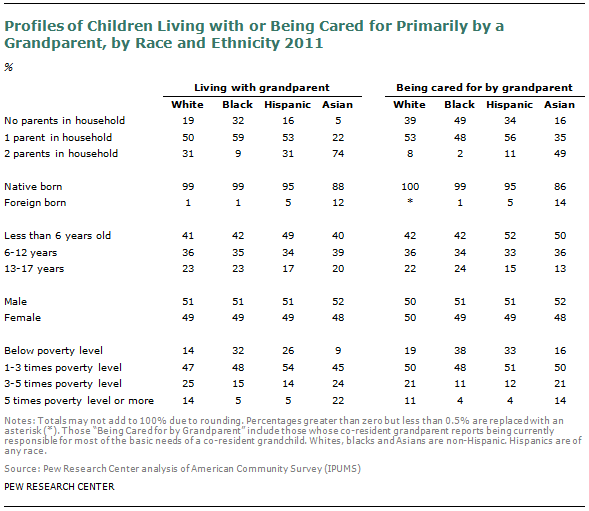
Nativity differences amidst children living with or being cared for primarily past a grandparent reflect the fact that a much larger share of Hispanic and Asian children in general are foreign born. Nearly all black and white children either living with or being cared for primarily by a grandparent are native born; for Hispanic children, the share drops slightly to 95%. And some 88% of Asian children living with a grandparent are native built-in, as are 86% of Asian children existence cared for primarily by a grandparent.
Among children living with their grandparents, Hispanics tend to be a flake younger than others—fully 49% are less than 6 years of historic period. Conversely, 17% are ages 13 to 17, compared with 23% of white and black children and 20% of Asian children. Among children being cared for primarily past grandparents, both Hispanics and Asians are relatively young—about one-half are less than 6, compared with 42% of both whites and blacks.
There are notable racial and ethnic differences in the prevalence of poverty among these children. And again, this is largely reflective of overall racial and ethnic differences in poverty. While fourteen% of white and 9% of Asian children who live with their grandparent are living beneath the poverty line, this number rises to 26% among Hispanic children and 32% among black children living with a grandparent. At the other end of the spectrum, just v% of black and Hispanic children who live with a grandparent have household incomes at least five times the poverty level. This share rises to 14% for whites, and 22% for Asians.
The poverty profiles are similar amidst those children who are likewise existence cared for primarily by a grandparent. While 38% of blacks and 33% of Hispanics are in households with annual incomes below the poverty line, these shares are xix% among whites and 16% among Asians. And while just 4% of black and Hispanic children who are beingness cared for primarily by grandparents have household incomes that are at least five times the poverty level, the shares ascension to 11% for white children, and 14% for Asian children.
Is It True In The Us That The Amount Of Children Raised By Their Grandparents Has Increased?,
Source: https://www.pewresearch.org/social-trends/2013/09/04/children-living-with-or-being-cared-for-by-a-grandparent/
Posted by: cooperevines1973.blogspot.com


0 Response to "Is It True In The Us That The Amount Of Children Raised By Their Grandparents Has Increased?"
Post a Comment